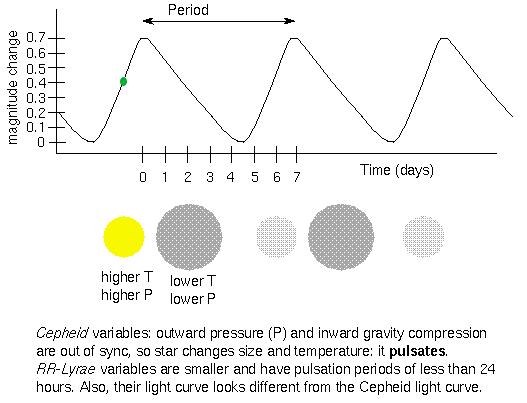Cepheid Variable Stars
Imagine a star that rhythmically expands and contracts like it’s breathing. That’s what a Cepheid variable does! These stars brighten and dim periodically, which makes them excellent cosmic lighthouses. Even with modern techniques like supernovae measurements and redshift, Cepheids remain a “gold standard” for distance measurements up to tens of millions of light-years.
A Cepheid variable is a type of variable star that pulsates radially, varying in both diameter and temperature. It changes in brightness, with a well-defined stable period and amplitude.
Types of Cepheid Variables
There are two main types of Cepheid variables:
-
Classical Cepheids: Young, massive stars found in the spiral arms of galaxies like our Milky Way. They pulsate over a period of 1 to 50 days.
-
Type II Cepheids: Older, less massive stars with shorter pulsation periods, typically found in globular clusters. They are important for studying older regions of the universe.
The first Cepheid variable ever discovered, Delta Cephei, is so famous that it gave its name to the entire class of these stars! Astronomers have been using Delta Cephei as a cosmic yardstick for over 200 years, and it’s located only about 887 light years away, making it one of the closest Cepheids to Earth. It’s like the celebrity of pulsating stars!
The Period-Luminosity Relationship
One of the most significant aspects of Cepheid variables is the period-luminosity relationship, discovered by Henrietta Leavitt in the early 1900s. This relationship states that the longer the pulsation period of a Cepheid star, the brighter the star actually is. This makes Cepheids essential tools for determining the distance to faraway galaxies. Why It Matters: By observing the period of a Cepheid’s pulsation, astronomers can determine its true luminosity (intrinsic brightness). Comparing this to how bright the star appears from Earth allows them to calculate its distance. This makes Cepheid variables cosmic yardsticks that help measure the size of the universe.
Cepheids were critical in helping Edwin Hubble discover that the universe is expanding. He used Cepheids in distant galaxies to prove they were moving away from us!
Reason of Pulsations of Cepheid Variables
The pulsation of Cepheid variables is due to the kappa mechanism, which involves the ionisation of helium in the star’s outer layers. Here’s how it works:
-
Ionisation of Helium: As the star’s outer layers heat up, helium atoms become ionised (He → He⁺ and He⁺ → He²⁺). This increases the opacity of the star’s atmosphere, trapping radiation and raising internal pressure.
-
Expansion: The increased pressure causes the star to expand. As it expands, the outer layers cool, reducing the ionisation of helium. Recombination: As the star cools, helium recombines into neutral helium, reducing opacity and allowing radiation to escape. This causes the pressure to drop.
-
Contraction: With less pressure, gravity pulls the star’s outer layers inward, causing the star to contract and heat up again, restarting the ionisation process.
This continuous cycle of heating, ionisation, expansion, cooling, recombination, and contraction drives the regular pulsations of Cepheid variables, resulting in their characteristic periodic brightness changes.
Below here, you can observe the light curve of a Cepheid variable that shows the variation in brightness of the star over time. Cepheid variables are a type of star whose brightness changes in a regular, periodic manner. The shape of their light curve is distinct and follows a repetitive pattern, corresponding to the pulsations of the star.

By using Cepheids, we’ve been able to refine our estimates for the Hubble constant, which in turn helps us estimate the age of the universe. These stars help us put a number on the vastness of time!
Henrietta Leavitt made groundbreaking discoveries in astrophysics without ever having access to a telescope! At the time, women were often restricted from using Harvard telescopes, but Leavitt used photographic plates and discovered the relationship between the brightness and the period of Cepheid variable stars and hence cepheid variables.